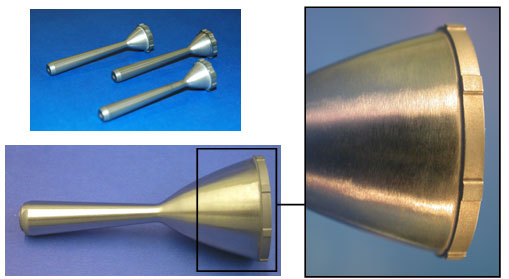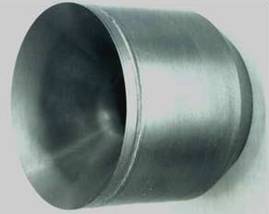Solid Rocket Engines
Ultramet uses chemical vapor deposition to fabricate near-net-shape solid rocket combustion chambers and throats from refractory metals and ceramics.
Refractory Metal Chambers and Throats
Rhenium and tungsten offer flight-proven performance in the aggressive thermal and chemical environment of solid rocket chambers and throats. The only ductile material that provides zero erosion with highly aluminized solid rocket propellants is rhenium.
Ultramet manufactures extremely thin wall rhenium chambers for divert and attitude control functions for the Navy’s advanced missile defense system. These chambers are created by high-volume batch processing, which keeps production costs low.

Thin-wall rhenium chambers manufactured by chemical vapor deposition at Ultramet for tactical propulsion applications
Refractory Metal Throats

Tungsten throat reinforced with tungsten foam
Tungsten is the material of choice when solid rocket propellant flame temperatures exceed the melting point of rhenium. Because tungsten can be used to coat a lighter weight material such as graphite or carbon/carbon, the cost and weight of a monolithic tungsten throat are avoided.
With its proficiency in chemical vapor deposition, Ultramet can manufacture tungsten throats as coated parts or freestanding inserts.
Ceramic-lined Throats

Ceramic-lined throat
Next-generation solid rocket propellants will have flame temperatures above the melting point of tungsten, so high temperature ceramics will be required. Ultramet can meet this demand with fiber-reinforced ceramic throats, ceramic-coated carbon/carbon throats, and/or hybrids of the two. Ultramet ceramic composites and coatings can also be used to prevent erosion in the exhaust nozzle.
TaC 7208°F (3987°C)*
HfC 7136°F (3947°C)*
*D.T. Vier, Thermal and Other Properties of Refractories, Technical Report Program R056, Los Alamos Scientific Laboratory for Defense Advanced Research Projects Agency, 1975.
